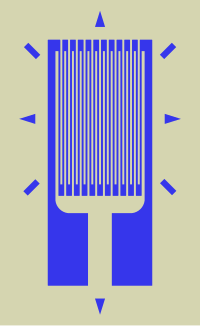
Photo from wikipedia
Measuring small-magnitude strain fields using a digital image correlation (DIC) technique is challenging, due to the noise-signal ratio in strain maps. Here, we determined the level of accuracy achievable in… Click to show full abstract
Measuring small-magnitude strain fields using a digital image correlation (DIC) technique is challenging, due to the noise-signal ratio in strain maps. Here, we determined the level of accuracy achievable in measuring small-magnitude (<0.1%) homogeneous strain fields. We investigated different sets of parameters for image processing and imaging pre-selection, based on single-image noise level. The trueness of DIC was assessed by comparison of Young’s modulus (E) and Poisson’s ratio (ν) with values obtained from strain gauge measurements. Repeatability was improved, on average, by 20–25% with experimentally-determined optimal parameters and image pre-selection. Despite this, the intra- and inter-specimen repeatability of strain gauge measurements was 5 and 2.5 times better than DIC, respectively. Moreover, although trueness was also improved, on average, by 30–45%, DIC consistently overestimated the two material parameters by 1.8% and 3.2% for E and ν, respectively. DIC is a suitable option to measure small-magnitude homogeneous strain fields, bearing in mind the limitations in achievable accuracy.
Journal Title: Materials
Year Published: 2018
Link to full text (if available)
Share on Social Media: Sign Up to like & get
recommendations!